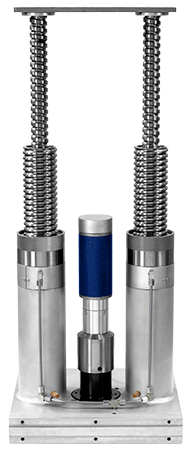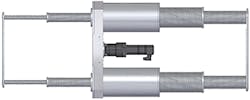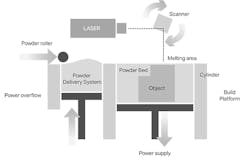An industrial 3D printer manufacturer faced a challenging task: How to drive its powder bed fusion system across a large span of travel with 0.02 mm accuracy and smooth vertical movement. The answer was telescopic actuation.
As manufacturers produce large products with highly precise dimensions, they are driving machine builders to adopt new positioning and motion technologies that can reliably achieve micron-level accuracy over long spans of movement.
Telescopic actuation enables a machine to smoothly position a component with up to 8-micron accuracy per stage, over a 4.85-meter range. The technology comprises components that operate reliably and consistently over the machine’s lifetime. It is ideal for special applications such as large 3D metal printers used in additive manufacturing or for positioning immense aerospace components that require ultra-precise dimensional accuracy.
Figure 2: A two-stage telescope actuator is a linear drive system designed for applications with long movement range and limited space requirements.
What is a telescopic actuator?
The telescopic actuator was developed to perform challenging drive and positioning tasks requiring extreme infeed accuracy and smooth operation (Figure 1). These tasks include displacement movements of components with complex, path-dependent processes, as well as pressing and joining tasks with direct force-path evaluation.
Telescopic actuators come in two-stage and four-stage versions and can operate in vertical and horizontal positions. Their compact designs produce micron-exact positioning, backlash-free movement and constant torque.
Long travel with limited spatial requirements
A two-stage telescope actuator is a linear drive system designed for applications with long movement range and limited space requirements (Figure 2). It achieves ultra-precise motion control plus the higher power transmission required in press and jig construction.
The actuator converts the central rotatory drive motion of its motor into an axial translation movement through two nested telescopic ball screws. The resulting partial movements split according to the thread pitches and occur synchronously. The highest precision positioning and repeat accuracies are achieved through backlash-free, preloaded double nuts and ball-screw spindles with ground precision in the accuracy quality ISO Tolerance (IT) 3. IT 3 describes the precision with which a ball is ground with accuracy classes (IT 1 to IT 10), described and specified in DIN 69051 and the International Organization for Standardization (ISO) 3408. The smaller the number the more precisely the ball screw has been manufactured.
Figure 3: A four-stage telescopic actuator combines the smallest possible structural dimensions with the greatest movement accuracy and large travel range.
The device’s torque and efficiency of the telescopic levels are constant across the entire length of travel. As a result, a telescopic actuator experiences minimal power losses and low operating temperatures. The two-stage actuator can handle large axial loads with extreme precision.
Compact four-stage actuator designed for space-saving applications
A four-stage telescopic actuator combines the smallest possible structural dimensions with the greatest movement accuracy and large travel range (Figure 3). Its compact design and high-precision positioning make it suitable for a wide variety of machine tool, power transmission, and press and jig applications.
As found in the two-stage actuator, the patented four-stage device converts the central rotatory drive motion of the motor into two counter-running axial translational movements through two nested precision telescopic ball screws. The resulting partial movements split according to the thread pitches and occur synchronously. Positioning and repeat accuracies are achieved through backlash-free, preloaded double nuts and ball-screw spindles.
Figure 4: The compact design of four-stage telescopic actuators makes them desirable for applications in confined spaces.
The telescopic, multi-stage ability of the ball-screw spindles makes it possible for the actuator to achieve a large extension with the shortest-possible retracted block length. Complex machine movements can be numerically controlled and safely monitored with this very compact unit. The preloaded ball-screw nuts guarantee freedom from backlash, even with high-tensile and compressive loads.
The actuator’s torque and efficiency of the telescopic levels are consistent across the entire range of motion. In this way, minimal power loss and low operating temperatures are experienced. The four-stage telescopic actuator is designed for high-precision, jerk-free positioning and movement in horizontal or vertical positions, and has one-way or two-way load-bearing capacity.
For applications requiring heavier axial loads, two-stage and four-stage actuators are available as dual systems. In these configurations, the parallel-arranged actuators are driven by a joint motor for highly accurate synchronous extension and retraction.
Ultra-precision over long ranges of motion
Telescopic actuation solves a wide range of applications that require highly precise motion control over large ranges of travel. It brings both cost and technical benefits to the machine builder:
- ultra-precise position capability over very large travel—up to 386%
- high power transmission rates with up to 98% efficiency
- compact construction and small block dimensions for mechanical engineering solutions in small spaces
- built-in durability and rigidity, with features such as nitride spindles, ensure greater wear resistance, maximum machine availability and long life
- operation in all positions for installation flexibility
- actuation positions storable in CNC control systems.
Two-stage actuators are ideal for machines and plant equipment where space is not a major concern. These applications include additive manufacturing, aerospace, special machine construction or process engineering.
The compact design of four-stage telescopic actuators make them desirable for applications in confined spaces. These include flexible aerospace and automotive machining and clamping systems that process large parts and assemblies (Figure 4).
Figure 5: In practice, a 3D metal printer provider could design a system for the additive manufacturing market.
Large-scale additive manufacturing
In practice, a 3D metal printer provider could design a system for the additive manufacturing market (Figure 5). The printer would enable manufacturers to produce specially shaped work pieces that could not be constructed by conventional methods.
Using 3D metal printing, these components would be lighter weight and could be fabricated in one piece instead of assembled from multiple parts.
The printer could use powder bed fusion technology to perform directed energy deposition. Two highly accurate vertical movements would be required to position the powder supply and powder overfill systems. This up-and-down travel would have to be soft, smooth and backlash-free, with the two stages running at the same time.
The printer manufacturer could select telescopic actuation to control the printer’s movement because no other motion control technology can provide the positional accuracy and repeatability demanded by the machine builder’s application.
In the first application, a two-stage telescopic actuator would control the stepwise upward movement of the powder chamber for exact layer deposition. This stage would require lower than 0.020 mm accuracy.
Also read: How to transform rotary motion into linear
In the second application, a dual-system two-stage telescopic actuator would position the stepwise downward movement of the powder overfill cylinder’s build platform. A 600-mm stroke would be required to optimize the accuracy and surface quality of the printed object.
With the actuator’s preloaded double nuts, backlash-free up and down movements under push/pull load would enable a best-quality working piece for the 3D printer user.
Conclusion
With manufacturers demanding the capability to build larger, more specialized components, machine builders are faced with a host of new challenges. Many of these requirements involve fabrication and movement of large components with extreme levels of dimensional and positional accuracy.
Telescopic actuation, enables machine builders to provide equipment that can manufacture these hard-to-build components and products. The technology enables a machine to incorporate smooth motion control with micron-level accuracy and do it reliably and consistently over the machine’s lifetime.
Michael Graf is product manager at Schneeberger. Contact him at [email protected].
About the Author
Michael Graf
Schneeberger

Leaders relevant to this article:





